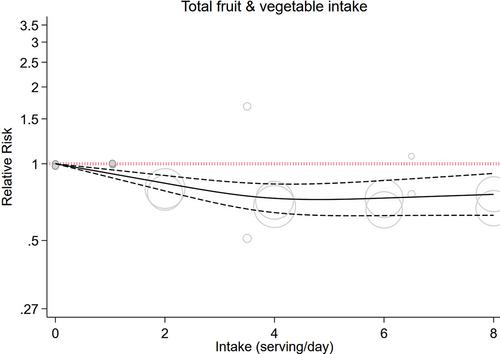下载PDF
{"title":"Fruit and Vegetable Consumption and the Risk of Bone Fracture: A Grading of Recommendations, Assessment, Development, and Evaluations (GRADE)-Assessed Systematic Review and Dose–Response Meta-Analysis","authors":"Sheida Zeraattalab-Motlagh, Seyed Mojtaba Ghoreishy, Arman Arab, Sara Mahmoodi, Amirhossein Hemmati, Hamed Mohammadi","doi":"10.1002/jbm4.10840","DOIUrl":null,"url":null,"abstract":"<p>Researchers have examined the link between consuming fruit and vegetables and the incidence of fractures for many years. Nevertheless, their findings have been unclear. Furthermore, the dose-dependent relationship has not been examined, and the level of certainty in the evidence was not evaluated. We carried out a dose-dependent meta-analysis examining the relation between fruit and vegetables intake and fracture incidence. PubMed, Web of Sciences, and Scopus were searched until April 2023 for cohort studies evaluating the relation between fruit and vegetables and fracture incidence. Summary relative risks (RRs) were computed from complied data by applying random effects analysis. To examine the level of evidence, we utilized the approach called the Grading of Recommendations, Assessment, Development, and Evaluations (GRADE). Ten cohort studies comprising 511,716 individuals were entered. There was a nonsignificant relation between fruit and vegetables, as well as only fruit intake and any fracture risk. In contrast, high versus low analysis presented that vegetables consumption was linked to a 16% decrease in any type of fracture incidence (RR 0.84; 95% confidence interval [CI], 0.75 to 0.95; <i>I</i><sup>2</sup> = 83.1%; <i>n</i> = 6). Also, per one serving/day (200 g/day) increments in vegetables consumption, there was a 14% decline in the fracture risk (RR 0.86; 95% CI, 0.77 to 0.97; <i>I</i><sup>2</sup> = 84.7%; <i>n</i> = 5; GRADE = moderate). With moderate certainty, a greater consumption of only vegetables, but not total fruit and vegetables or only fruit, might reduce the risk of fracture. These associations were also evident in dose–response analysis. Large intervention trials are demanded to approve our findings. © 2023 The Authors. <i>JBMR Plus</i> published by Wiley Periodicals LLC on behalf of American Society for Bone and Mineral Research.</p>","PeriodicalId":14611,"journal":{"name":"JBMR Plus","volume":"7 12","pages":""},"PeriodicalIF":3.4000,"publicationDate":"2023-11-10","publicationTypes":"Journal Article","fieldsOfStudy":null,"isOpenAccess":false,"openAccessPdf":"https://asbmr.onlinelibrary.wiley.com/doi/epdf/10.1002/jbm4.10840","citationCount":"0","resultStr":null,"platform":"Semanticscholar","paperid":null,"PeriodicalName":"JBMR Plus","FirstCategoryId":"1085","ListUrlMain":"https://onlinelibrary.wiley.com/doi/10.1002/jbm4.10840","RegionNum":0,"RegionCategory":null,"ArticlePicture":[],"TitleCN":null,"AbstractTextCN":null,"PMCID":null,"EPubDate":"","PubModel":"","JCR":"Q2","JCRName":"ENDOCRINOLOGY & METABOLISM","Score":null,"Total":0}
引用次数: 0
引用
批量引用
Abstract
Researchers have examined the link between consuming fruit and vegetables and the incidence of fractures for many years. Nevertheless, their findings have been unclear. Furthermore, the dose-dependent relationship has not been examined, and the level of certainty in the evidence was not evaluated. We carried out a dose-dependent meta-analysis examining the relation between fruit and vegetables intake and fracture incidence. PubMed, Web of Sciences, and Scopus were searched until April 2023 for cohort studies evaluating the relation between fruit and vegetables and fracture incidence. Summary relative risks (RRs) were computed from complied data by applying random effects analysis. To examine the level of evidence, we utilized the approach called the Grading of Recommendations, Assessment, Development, and Evaluations (GRADE). Ten cohort studies comprising 511,716 individuals were entered. There was a nonsignificant relation between fruit and vegetables, as well as only fruit intake and any fracture risk. In contrast, high versus low analysis presented that vegetables consumption was linked to a 16% decrease in any type of fracture incidence (RR 0.84; 95% confidence interval [CI], 0.75 to 0.95; I 2 = 83.1%; n = 6). Also, per one serving/day (200 g/day) increments in vegetables consumption, there was a 14% decline in the fracture risk (RR 0.86; 95% CI, 0.77 to 0.97; I 2 = 84.7%; n = 5; GRADE = moderate). With moderate certainty, a greater consumption of only vegetables, but not total fruit and vegetables or only fruit, might reduce the risk of fracture. These associations were also evident in dose–response analysis. Large intervention trials are demanded to approve our findings. © 2023 The Authors. JBMR Plus published by Wiley Periodicals LLC on behalf of American Society for Bone and Mineral Research.
水果和蔬菜摄入量与骨折风险:建议、评估、发展和评价分级(GRADE)评估的系统性综述和剂量反应元分析
多年来,研究人员一直在研究食用水果和蔬菜与骨折发生率之间的联系。然而,他们的研究结果并不明确。此外,还没有研究过剂量依赖关系,也没有评估过证据的确定性水平。我们进行了一项剂量依赖性荟萃分析,研究水果和蔬菜摄入量与骨折发生率之间的关系。截至 2023 年 4 月,我们在 PubMed、Web of Sciences 和 Scopus 上检索了评估水果和蔬菜与骨折发生率之间关系的队列研究。通过应用随机效应分析法,从汇总的数据中计算出汇总相对风险(RRs)。为了考察证据的水平,我们采用了名为 "建议、评估、发展和评价分级"(GRADE)的方法。十项队列研究共涉及 511 716 人。水果和蔬菜之间以及仅水果摄入量与任何骨折风险之间的关系均不显著。相比之下,高与低的分析表明,蔬菜摄入量与任何类型骨折发病率下降 16% 有关(RR 0.84;95% 置信区间 [CI],0.75 至 0.95;I2 = 83.1%;n = 6)。此外,蔬菜消费量每增加一份/天(200 克/天),骨折风险就会下降 14%(RR 0.86;95% CI,0.77 至 0.97;I2 = 84.7%;n = 5;GRADE = 中等)。在中度确定性的情况下,多吃蔬菜,而不是多吃水果和蔬菜或只吃水果,可能会降低骨折风险。这些关联在剂量反应分析中也很明显。我们需要大型干预试验来验证我们的研究结果。© 2023 作者。JBMR Plus 由 Wiley Periodicals LLC 代表美国骨与矿物质研究学会出版。
本文章由计算机程序翻译,如有差异,请以英文原文为准。



